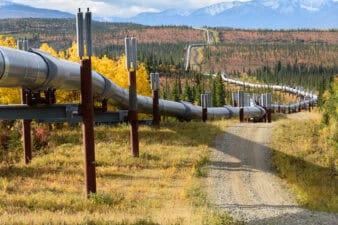Suncor Energy Inc. (TSX:SU)(NYSE:SU) recently released its Q1 2015 earnings, and the company posted a $341 million loss, or $-0.24 per share. Looking deeper, however, it is obvious that Q1 was an incredibly positive quarter for Suncor, and the share price—which has remained stable after a steady climb—reflected this.
Why was it a positive quarter for Suncor? Well, the negative earnings number is a poor reflection of the company’s profit due to the fact it reflected several one-off expenses, which included a $940 million charge from its U.S. denominated debt being revalued upwards due to the strong U.S. dollar. Looking to the company’s cash flow, which excludes non-cash charges, the company actually posted similar cash flow to Q4 2014 and greater free cash flow, despite lower oil prices.
The reason is because Suncor has been using the low oil price environment to improve its cost structure and enhance its operational excellence.
1) Suncor has used low oil prices as an opportunity to reduce costs.
On the cost-reduction front, Suncor has realized massive improvements in operating costs and capital costs. Previously Suncor announced $600-800 million in operating budget reductions to be realized over a two-year period, and Suncor now expects these reductions not only to be realized in 2015—a year ahead of schedule—but also to overachieve its $800 million reduction, which could reduce costs and increase cash flows further.
Nowhere is this progress more notable than in the company’s oil sands operations. In Q4 2014 the company reported cash operating costs of $34.45 per barrel. In Q1 2015 the company managed to achieve a huge 20% reduction in costs, posting a cash cost per barrel of $28.40 per barrel. Cash costs for in situ oil sands operations were a record low of $14 per barrel, and the overall cash cost of $28.40 per barrel works out to US$23 per barrel, which is a low not realized since Q3 2008.
Suncor’s cash operating costs per barrel were nearly $40 in 2011, demonstrating how far the company has come, and how the company is using low oil prices as an opportunity to improve its cost structure. Most importantly, much of this reduction was due to factors within the company’s control, including progress from cost-reduction initiatives and better reliability.
2) Suncor is improving reliability
Operational excellence is one of the key parts of Suncor’s strategy, which means ensuring upgrading facilities operate at high utilization rates with minimal downtime for maintenance. By focusing on reliability, Suncor is ensuring its cash flows can remain strong even in weak oil price environments.
This, in turn, results in higher production, which is critical because operating and capital costs are fairly fixed, so high production is necessary to spread those costs across as many barrels as possible to reduce operating costs. Excellent reliability from Suncor’s oil sands operations were one of the factors driving Suncor’s extremely low cash operating cost per barrel.
Overall, Suncor’s upstream production was 602,000 boe/d, which represented a 10% increase from Q1 2015. This increase was largely driven by record oil sands production of 440,000 boe/d, which represented a 13% increase from Q1 2015, and included record production of synthetic crude.
These huge improvements in production are due to the fact that Suncor had improved reliability across its oil sands assets, low amounts of maintenance, and no unplanned downtime.
Syncrude recently completed numerous major capital projects that are all geared towards improving reliability, and these projects should work to increase utilization at Syncrude, and therefore boost production and lower maintenance costs.








